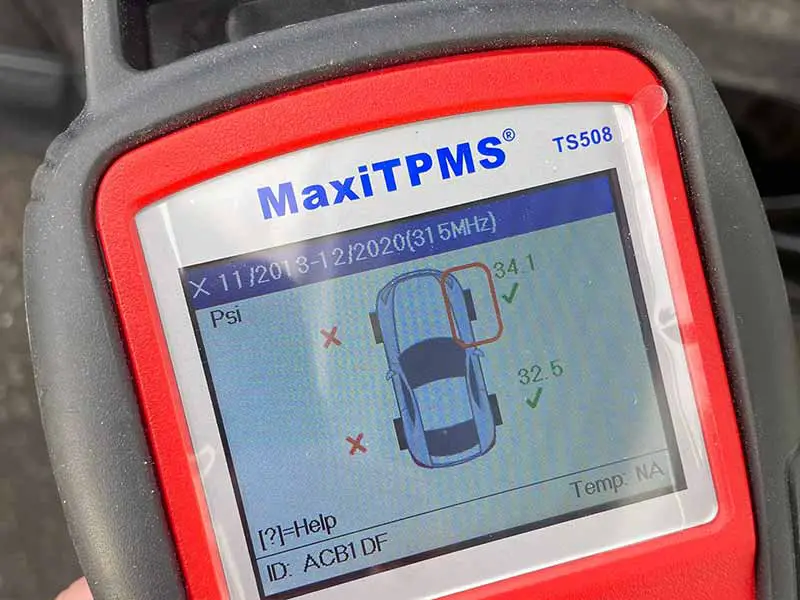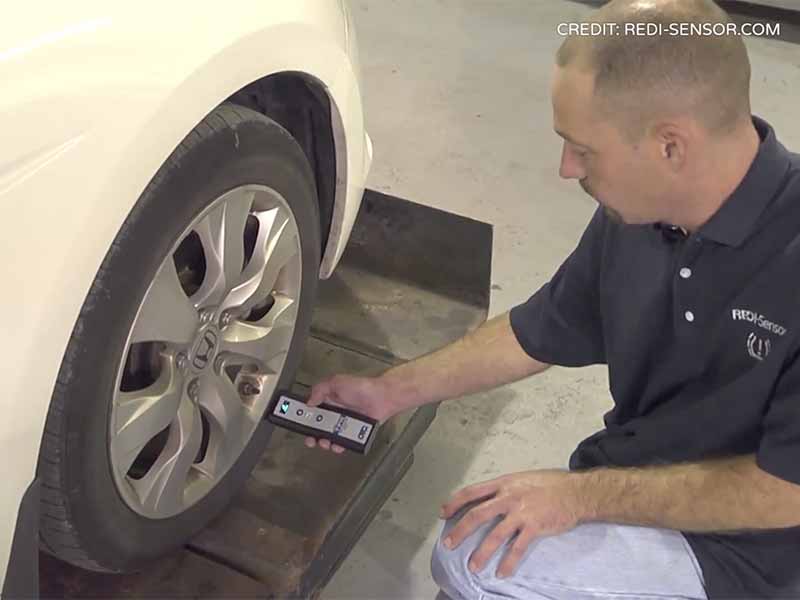Ever found yourself puzzled by a TPMS malfunction light on your dashboard, only to discover that the culprit is a duplicate sensor ID? You’re not alone. Many vehicle owners face this issue, unaware of the steps to correct it.
How To Fix Duplicate TPMS Sensor IDs
Fixing a duplicate TPMS sensor ID involves identifying the sensor with the duplicated ID, re-programming or changing its unique identifier with a TPMS scan tool, and then performing a relearn procedure to sync all the sensors with the vehicle’s TPMS module.
In this article, we’ll delve deep into understanding the basics of TPMS sensors, identifying issues related to duplicated sensor IDs, actionable steps to rectify these issues, and additional tips to maintain your TPMS for optimal performance and safety.

Understanding the Basics
The Tire Pressure Monitoring System (TPMS) is an integral component of modern vehicles, designed to monitor the air pressure inside the tires. It plays a pivotal role in ensuring that your tires are inflated to the optimal pressure, which is crucial for safe driving and tire longevity. When the TPMS detects a significant drop or rise in tire pressure, it triggers an alert, usually in the form of a light on your dashboard.
For a deeper dive into how these sensors work, check out our detailed guide on how tire pressure sensors work.
Why Unique Sensor IDs Matter
Every TPMS sensor is equipped with a unique ID to differentiate it from other sensors in the system. This unique identifier ensures that the TPMS module can accurately read the pressure from each tire and display it to the driver. Imagine having two or more sensors with the same ID; it would be like having two people with the same phone number. Confusing, right? In the world of TPMS, duplicated sensor IDs can lead to inaccurate readings and potential safety risks.
If you ever encounter issues with new TPMS sensors not reading correctly, our guide on new TPMS sensor not reading can provide further insights.

Identifying the Issue
The TPMS malfunction light is a clear indicator that there’s an issue with your tire pressure monitoring system. This light, typically represented by an exclamation mark inside a tire symbol, illuminates on your dashboard when the system detects an anomaly. While it could be due to various reasons, one common cause is the duplication of sensor IDs.
For those who’ve recently replaced or adjusted their TPMS sensors and are facing issues, it’s crucial to understand the relearn procedure for TPMS sensors. This process ensures that your vehicle’s system recognizes and accurately reads each sensor.
Sensors Display: Spotting Duplicated IDs
To identify if you have duplicated sensor IDs, you’ll need to access the TPMS sensors display, usually available on your vehicle’s dashboard or through a specialized tool. This display provides real-time data from each sensor. If you notice that two or more readings are identical or if a particular tire’s reading is missing, it’s a strong indication of duplicated IDs.
Remember, while the process might seem technical, with the right guidance and tools, even novices can spot and rectify these issues. Ensuring that each sensor has a unique ID is paramount for accurate tire pressure readings and, ultimately, your safety on the road.

Taking Action: Fixing the Duplicate ID
Changing the TPMS sensor ID is a crucial step in rectifying the issue of duplicated IDs. This process involves accessing the TPMS module, identifying the sensor with the duplicated ID, and assigning it a new, unique identifier. While this might sound technical, with the right tools and guidance, it’s a straightforward procedure.
For those who are looking to delve deeper into the intricacies of TPMS sensors and their programming, our comprehensive guide on how to program TPMS sensors offers a wealth of information.
Re-programming the MX-Sensor with a Unique ID
The MX-Sensor is a popular type of TPMS sensor used in many vehicles. If you’ve identified that your MX-Sensor has a duplicated ID, re-programming it is essential. This process involves using a specialized tool to access the sensor’s settings, clearing the existing ID, and assigning a new one. Once re-programmed, the sensor will transmit its readings with the new ID, ensuring accurate and individual readings for each tire.
The Relearn Procedure: Syncing All the Sensors
After changing or re-programming sensor IDs, it’s vital to perform a relearn procedure. This process ensures that the vehicle’s TPMS module recognizes and syncs with all the sensors, displaying accurate readings. The relearn procedure might vary depending on the vehicle make and model, but generally involves driving the vehicle for a specific distance or time to allow the system to reset and recognize each sensor.

Autel MaxiTPMS Scan Tool
Additional Tips for TPMS Maintenance
Tire rotation is an essential maintenance task that ensures even tire wear, prolonging the lifespan of your tires. But did you know it also plays a role in TPMS functionality? When you rotate your tires, it’s crucial to ensure that the TPMS sensors are correctly aligned with their respective positions. This ensures that the readings displayed correspond to the correct tire, providing you with accurate data.
Activating Sensors After Maintenance
Whenever you perform maintenance on your tires or TPMS sensors, it’s essential to activate the sensors. This process ensures that they are transmitting data and that the TPMS module is receiving it. Activation can be done using specialized tools or, in some cases, by simply driving the vehicle for a short distance.
Sensor Programming: A Crucial Step
Correct sensor programming is the backbone of an effective TPMS. Whether you’re installing new sensors or re-programming existing ones, ensuring they are correctly programmed is paramount. This involves setting each sensor with a unique ID and ensuring it transmits data at the correct frequency. For a more in-depth look at the intricacies of sensor programming and to avoid common pitfalls, explore our guide on how TPMS sensors work.

Autel MX Sensor (Metal Valve Stem)
TPMS Sensor Cloning Vs. Reprogramming
When it comes to managing the unique IDs of TPMS sensors, two primary methods stand out: cloning and reprogramming. Both approaches aim to ensure that the TPMS system functions correctly, but they differ in their processes and applications. Let’s delve into the nuances of each method to provide a clearer understanding.
TPMS Sensor Cloning
Cloning involves copying the unique ID from the original sensor and transferring it to a new sensor. This method ensures that the vehicle’s TPMS module continues to recognize the new sensor as if it were the original.
- Advantages:
- Simplifies the replacement process, especially for DIY enthusiasts.
- No need for a relearn procedure after installation.
- Ideal for vehicles that have complex or lengthy relearn processes.
- Disadvantages:
- Requires specialized tools to clone the sensor ID.
- If the original sensor’s ID was compromised (e.g., duplicated), cloning would perpetuate the issue.
TPMS Sensor Reprogramming
Reprogramming involves assigning a new unique ID to the sensor. This method is typically used when the original sensor’s ID is compromised or when installing a completely new set of sensors.
- Advantages:
- Addresses issues of duplicated or compromised sensor IDs.
- Provides a fresh start, ensuring that each sensor has a unique ID.
- Can be done using various TPMS tools available in the market.
- Disadvantages:
- Requires a relearn procedure to sync the new sensor IDs with the vehicle’s TPMS module.
- Might be more time-consuming than cloning, especially for those unfamiliar with the process.
Resources
Below are some links you may find helpful when learning about tires:
- C5 and C6 tire pressure monitoring system – Technically Speaking – MotorTrend
- Why does my tool display a “Duplicate Sensor ID” warning message – Autel
Final Thoughts
By understanding the intricacies of TPMS sensors, especially the importance of unique sensor IDs, vehicle owners can take proactive steps to address issues like duplicated IDs.
With the right knowledge and tools, even seemingly complex tasks like re-programming a sensor or performing a relearn procedure become manageable.
Good luck and happy motoring.





